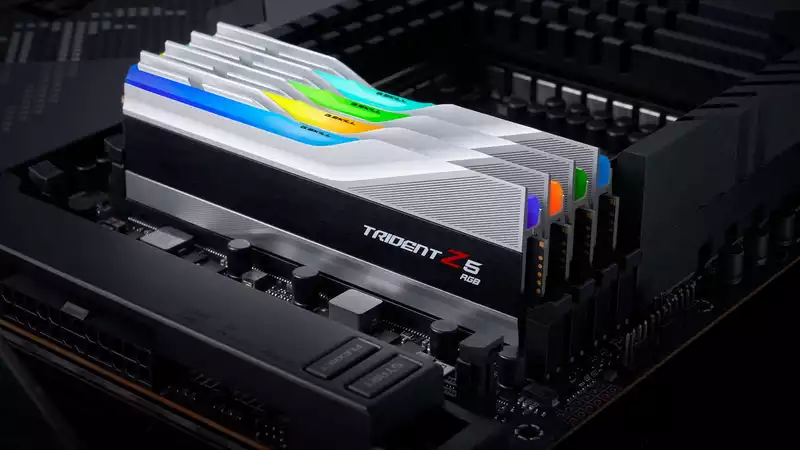The latest DDR5 standard is off to a rocky start. Not because of its performance, but because of supply and demand, as is the case with much of the technology in 2021. Kits like the G.Skill Trident Z5 RGB DDR5-6000 we are reviewing are out of stock everywhere. We know from our vendor contacts that this is not always the case, as inventory levels gradually increase from January onward. So, rather than rant about supply and demand issues, we will focus on the kits themselves, knowing that once inventory is available, an analysis of the kits will be required rather than outdated rants about the availability from a particular point in time.
Hopefully this review will become more relevant once people are actually able to purchase them.
No matter what background noise there is, G.Skill always releases the highest performing memory. Their high-performance Samsung B-die DDR4 kits are widely regarded as the best on the market. We have always had high expectations for the company, and their DDR5-6000 kit with 36-36-36-76 timings is nearly as good as the first wave of DDR5 kits. [This kit supports XMP 3.0, has an operating voltage of 1.30V, and has a capacity of 2 x 16GB. We used this kit on a variety of Z690 motherboards, and other than a few glitches with the pre-release BIOS, all motherboards ran fine at XMP rated speeds once the new BIOS arrived.
Looks are always an eye catcher, and in my opinion, G.Skill is a nice looking kit. Our sample features silver heat spreaders, but there is a black version available if you prefer. It doesn't look too inorganic like some G.Skill kits, and the RGB implementation looks great. Its opaque cover and diffused light are a bit more subdued than some kits with excessive branding and eye-poppingly bright individual LEDs.
G.Skill has its own RGB app called Trident Z Lighting Control. This app is lightweight, downloading only 6 MB. Such a simple app would be a refreshing alternative to the excessive motherboard control software (Asus Armory Crate) that users are often forced to deal with I had a quick play with the Trident app and had no problems. All the standard effects and controls are present and correct. But if you already have a motherboard control app, the G.Skill kit should also integrate seamlessly with RGB control software from Asus, Gigabyte, MSI, and ASRock.
With specs like these, you should expect excellent performance, and the G.Skill modules certainly provide that, but as is common with fast memory, the benefits tend to manifest themselves in a rather limited way. However, as is often the case with fast memory, the benefit tends to manifest itself only in a limited way.
File compression and video encoder are good tests and show the G.Skill kit performing well. the Handbrake video encoding test shows that the proper speed increases as bandwidth increases. the G.Skill kit is Latency is low for DDR5, on par with the top-of-the-line Team kit. Note that in bandwidth-sensitive applications, the G.Skill kit easily outperforms the DDR4 kit.
While bandwidth can make a difference, games tend to prefer lower latency, although this varies from game to game. In this regard, the low latency of a proper DDR4-3600 C16 kit will prove perfectly viable on a 12th generation gaming system. However, the raw bandwidth of the G.Skill kit overcomes this, and even in GPU-limited situations such as those seen in Metro: Exodus, G.Skill can outperform DDR4 kits.
Honestly, at the end of the day, you don't have to pay a fortune for fast memory; if you have an Intel Core i9 12900K and a GeForce RTX 3080 or Radeon RX 6900 XT, it's worth getting a fast kit. For lower spec systems, DDR4 kits or DDR5-5200 MHz range will not be penalized in real scenarios or specific situations.
Overclocking the G.Skill kit was an interesting exercise. Since we are still at the dawn of the DDR5 era, Samsung-based kits are particularly rare and extensive support seems to still be a work in progress. Our Asus Maximus Z690 Apex (built specifically for DDR5 overclockers) has no official QVL support for Samsung-based kits at all. However, our kit worked fine with the rated XMP 3.0 6000MHz spec.
Better Samsung support will come down the road, as G.Skill itself says that Apex is officially supported along with 12 other boards, some in the Z690 BIOS to take full advantage of Samsung, and all DDR5 memory, Some of them will still need to be matured. The kit was able to boot at 6400Mhz C40, but it needed a lot of VDDQ voltage. However, it is possible that the CPU is reaching its limits. It is also possible that G.Skill is actively discarding ICs for future kits above 6400 MHz. It is certain that. [I really like the G.Skill Trident Z5 kit. It's fast, looks good, and is a good example of what a fast DDR5 launch kit can do - you'd be crazy to buy it at duff prices in December 2021, but even at street prices it will be way down. [If you have a low-latency DDR4-3200 or 3600 kit, don't buy it. But if you have a gaming rig with similarly high-end components, you'll want a kit like G.Skill's to get the best out of your system.
The G.Skill DDR5-6000 C36 kit is a strong contender for the best DDR5 kit on the market, and as of December 2021, I'd say it exists, if not really on the market. There may be cheaper RAM out there, but nothing better. Whether your system deserves such a kit is up to you.
Prices will improve, no doubt, and I wouldn't recommend it right now, but that will change once supplies stabilize. When that happens, DDR5 will become more attractive. I'm sure it won't be long before the availability and relative value of this G.Skill Trident Z5 kit adds to its already well-rounded performance and appeal.
.

Comments